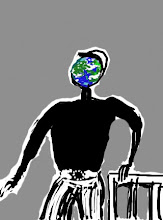Friday 19 October 2012
Invisible Retina
Wells's invisible man ought to be blind, of course (an invisible retina stops no photons). But he isn't. His blindness is of another sort. But there's a secret logic to Wells' dramatic elision of physical impossibility -- and we have to concede that a blind Griffin, stumbling helplessly about the Sussex countryside, would give a writer fewer opportunities for compelling storytelling. We approach it by comparing the quasi-scientific literalism of Wells's fable with the approach taken, for example, by Ralph Ellison in his powerful 1952 novel Invisible Novel, or Christopher Priest in his later The Glamour (1984). Both of those novels concern invisible characters, but in both instances they are invisible only in the sense that people somehow don't notice them. Otherwise their flesh is as good as stopping photons as yours or mine. The contrast with Wells's Griffin is instructive. Science (or pseudo-science) has made him literally invisible. But, because rather than despite this, people notice him all the time. His Gyges ambition compels him to meddle with the world, to disturb people and roil up the town, and this makes him the centre of attention.
Subscribe to:
Post Comments (Atom)

1 comment:
Wikipedia says: “Russian writer Yakov I. Perelman pointed out in Physics Can Be Fun (1913) that from a scientific point of view, a man made invisible by Griffin's method should have been blind, since a human eye works by absorbing incoming light, not letting it through completely. Wells seems to show some awareness of this problem in Chapter 20, where each of the eyes of an otherwise invisible cat retains a visible retina.”
I write a webcomic that has a planet with a zone that makes things invisible and therefore blind. It deals with about how animals evolved to cope with invisibility and blindness.
Post a Comment